Analysis: Is Clean Dressing a Safe Option for Surgical Wounds?
VerifiedAdded on 2023/06/12
|6
|1696
|472
Essay
AI Summary
This essay explores whether clean wound dressing is a safe option for surgical wounds, comparing it to the sterile technique. It examines recommendations from the Centres of Disease Control and Prevention, research comparing clean and sterile dressings, and surveys on dressing technique preferences among nurses. The analysis considers the advantages and disadvantages of both techniques, including cost-effectiveness, risk of infection, and the importance of proper nursing care. While sterile techniques are often favored for high-risk wounds, the essay concludes that a lack of conclusive evidence prevents definitively deeming clean dressing techniques unsafe when performed with meticulous hand hygiene, clean gloves, and appropriate disinfectants, emphasizing that diligent nursing care is crucial for the success of either method.
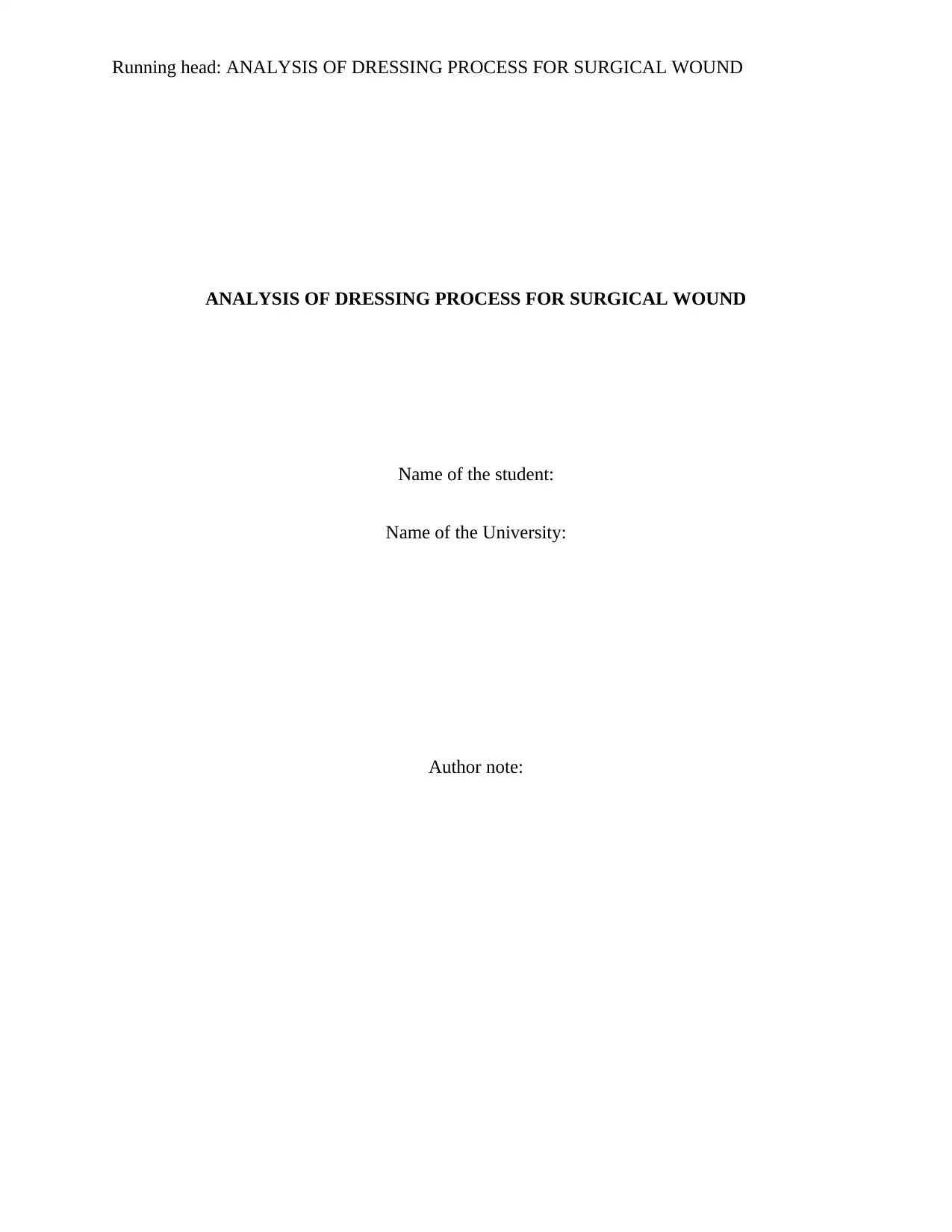
Running head: ANALYSIS OF DRESSING PROCESS FOR SURGICAL WOUND
ANALYSIS OF DRESSING PROCESS FOR SURGICAL WOUND
Name of the student:
Name of the University:
Author note:
ANALYSIS OF DRESSING PROCESS FOR SURGICAL WOUND
Name of the student:
Name of the University:
Author note:
Paraphrase This Document
Need a fresh take? Get an instant paraphrase of this document with our AI Paraphraser
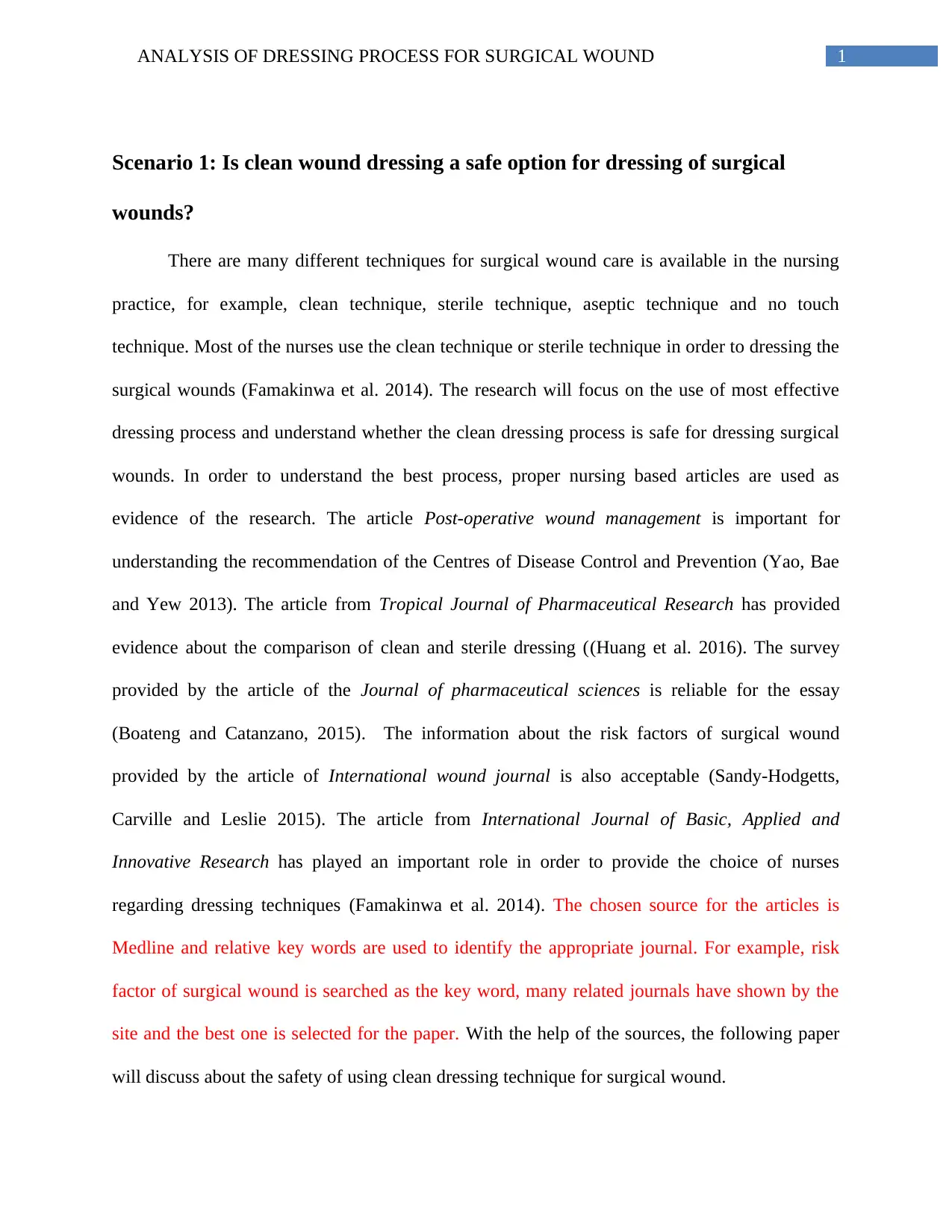
1ANALYSIS OF DRESSING PROCESS FOR SURGICAL WOUND
Scenario 1: Is clean wound dressing a safe option for dressing of surgical
wounds?
There are many different techniques for surgical wound care is available in the nursing
practice, for example, clean technique, sterile technique, aseptic technique and no touch
technique. Most of the nurses use the clean technique or sterile technique in order to dressing the
surgical wounds (Famakinwa et al. 2014). The research will focus on the use of most effective
dressing process and understand whether the clean dressing process is safe for dressing surgical
wounds. In order to understand the best process, proper nursing based articles are used as
evidence of the research. The article Post-operative wound management is important for
understanding the recommendation of the Centres of Disease Control and Prevention (Yao, Bae
and Yew 2013). The article from Tropical Journal of Pharmaceutical Research has provided
evidence about the comparison of clean and sterile dressing ((Huang et al. 2016). The survey
provided by the article of the Journal of pharmaceutical sciences is reliable for the essay
(Boateng and Catanzano, 2015). The information about the risk factors of surgical wound
provided by the article of International wound journal is also acceptable (Sandy‐Hodgetts,
Carville and Leslie 2015). The article from International Journal of Basic, Applied and
Innovative Research has played an important role in order to provide the choice of nurses
regarding dressing techniques (Famakinwa et al. 2014). The chosen source for the articles is
Medline and relative key words are used to identify the appropriate journal. For example, risk
factor of surgical wound is searched as the key word, many related journals have shown by the
site and the best one is selected for the paper. With the help of the sources, the following paper
will discuss about the safety of using clean dressing technique for surgical wound.
Scenario 1: Is clean wound dressing a safe option for dressing of surgical
wounds?
There are many different techniques for surgical wound care is available in the nursing
practice, for example, clean technique, sterile technique, aseptic technique and no touch
technique. Most of the nurses use the clean technique or sterile technique in order to dressing the
surgical wounds (Famakinwa et al. 2014). The research will focus on the use of most effective
dressing process and understand whether the clean dressing process is safe for dressing surgical
wounds. In order to understand the best process, proper nursing based articles are used as
evidence of the research. The article Post-operative wound management is important for
understanding the recommendation of the Centres of Disease Control and Prevention (Yao, Bae
and Yew 2013). The article from Tropical Journal of Pharmaceutical Research has provided
evidence about the comparison of clean and sterile dressing ((Huang et al. 2016). The survey
provided by the article of the Journal of pharmaceutical sciences is reliable for the essay
(Boateng and Catanzano, 2015). The information about the risk factors of surgical wound
provided by the article of International wound journal is also acceptable (Sandy‐Hodgetts,
Carville and Leslie 2015). The article from International Journal of Basic, Applied and
Innovative Research has played an important role in order to provide the choice of nurses
regarding dressing techniques (Famakinwa et al. 2014). The chosen source for the articles is
Medline and relative key words are used to identify the appropriate journal. For example, risk
factor of surgical wound is searched as the key word, many related journals have shown by the
site and the best one is selected for the paper. With the help of the sources, the following paper
will discuss about the safety of using clean dressing technique for surgical wound.
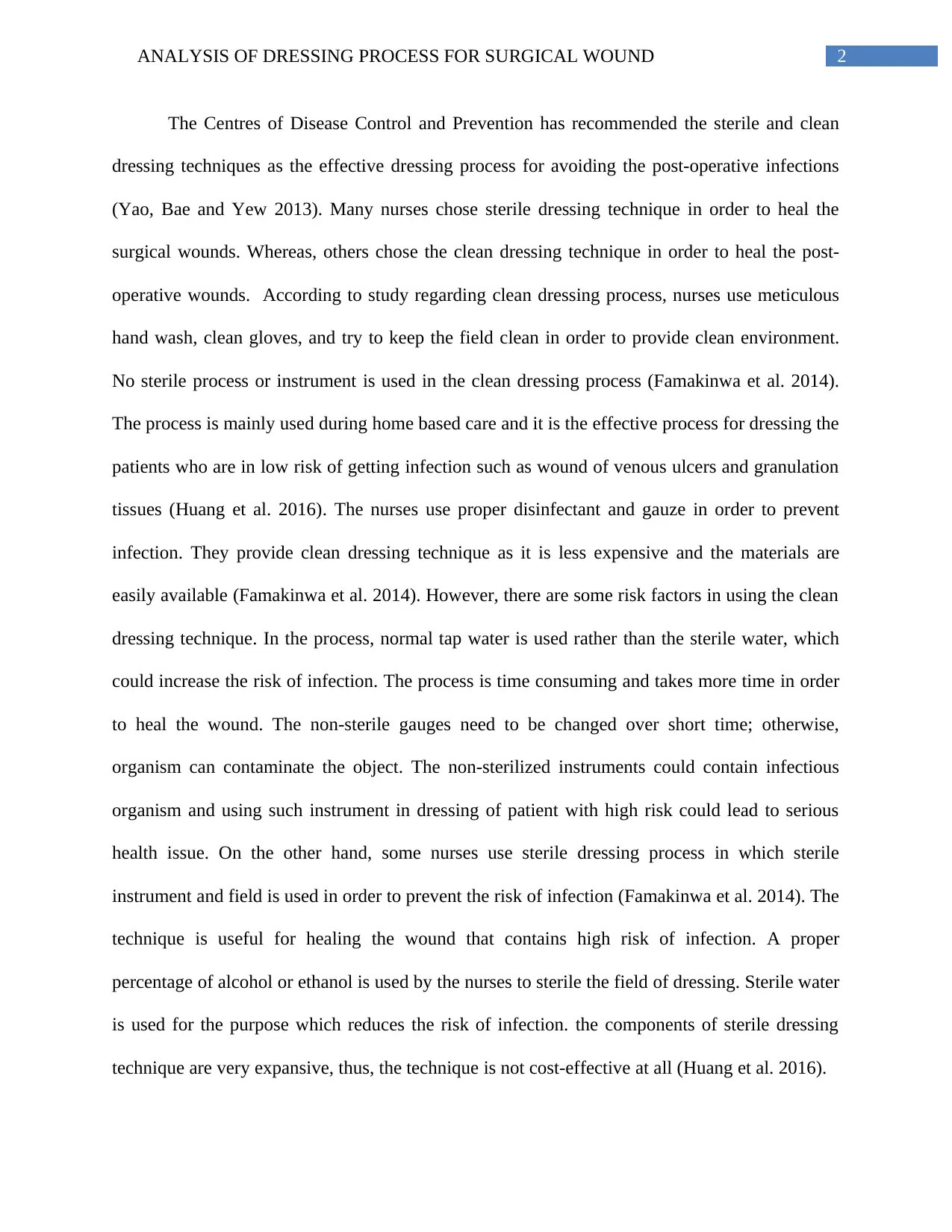
2ANALYSIS OF DRESSING PROCESS FOR SURGICAL WOUND
The Centres of Disease Control and Prevention has recommended the sterile and clean
dressing techniques as the effective dressing process for avoiding the post-operative infections
(Yao, Bae and Yew 2013). Many nurses chose sterile dressing technique in order to heal the
surgical wounds. Whereas, others chose the clean dressing technique in order to heal the post-
operative wounds. According to study regarding clean dressing process, nurses use meticulous
hand wash, clean gloves, and try to keep the field clean in order to provide clean environment.
No sterile process or instrument is used in the clean dressing process (Famakinwa et al. 2014).
The process is mainly used during home based care and it is the effective process for dressing the
patients who are in low risk of getting infection such as wound of venous ulcers and granulation
tissues (Huang et al. 2016). The nurses use proper disinfectant and gauze in order to prevent
infection. They provide clean dressing technique as it is less expensive and the materials are
easily available (Famakinwa et al. 2014). However, there are some risk factors in using the clean
dressing technique. In the process, normal tap water is used rather than the sterile water, which
could increase the risk of infection. The process is time consuming and takes more time in order
to heal the wound. The non-sterile gauges need to be changed over short time; otherwise,
organism can contaminate the object. The non-sterilized instruments could contain infectious
organism and using such instrument in dressing of patient with high risk could lead to serious
health issue. On the other hand, some nurses use sterile dressing process in which sterile
instrument and field is used in order to prevent the risk of infection (Famakinwa et al. 2014). The
technique is useful for healing the wound that contains high risk of infection. A proper
percentage of alcohol or ethanol is used by the nurses to sterile the field of dressing. Sterile water
is used for the purpose which reduces the risk of infection. the components of sterile dressing
technique are very expansive, thus, the technique is not cost-effective at all (Huang et al. 2016).
The Centres of Disease Control and Prevention has recommended the sterile and clean
dressing techniques as the effective dressing process for avoiding the post-operative infections
(Yao, Bae and Yew 2013). Many nurses chose sterile dressing technique in order to heal the
surgical wounds. Whereas, others chose the clean dressing technique in order to heal the post-
operative wounds. According to study regarding clean dressing process, nurses use meticulous
hand wash, clean gloves, and try to keep the field clean in order to provide clean environment.
No sterile process or instrument is used in the clean dressing process (Famakinwa et al. 2014).
The process is mainly used during home based care and it is the effective process for dressing the
patients who are in low risk of getting infection such as wound of venous ulcers and granulation
tissues (Huang et al. 2016). The nurses use proper disinfectant and gauze in order to prevent
infection. They provide clean dressing technique as it is less expensive and the materials are
easily available (Famakinwa et al. 2014). However, there are some risk factors in using the clean
dressing technique. In the process, normal tap water is used rather than the sterile water, which
could increase the risk of infection. The process is time consuming and takes more time in order
to heal the wound. The non-sterile gauges need to be changed over short time; otherwise,
organism can contaminate the object. The non-sterilized instruments could contain infectious
organism and using such instrument in dressing of patient with high risk could lead to serious
health issue. On the other hand, some nurses use sterile dressing process in which sterile
instrument and field is used in order to prevent the risk of infection (Famakinwa et al. 2014). The
technique is useful for healing the wound that contains high risk of infection. A proper
percentage of alcohol or ethanol is used by the nurses to sterile the field of dressing. Sterile water
is used for the purpose which reduces the risk of infection. the components of sterile dressing
technique are very expansive, thus, the technique is not cost-effective at all (Huang et al. 2016).
⊘ This is a preview!⊘
Do you want full access?
Subscribe today to unlock all pages.

Trusted by 1+ million students worldwide
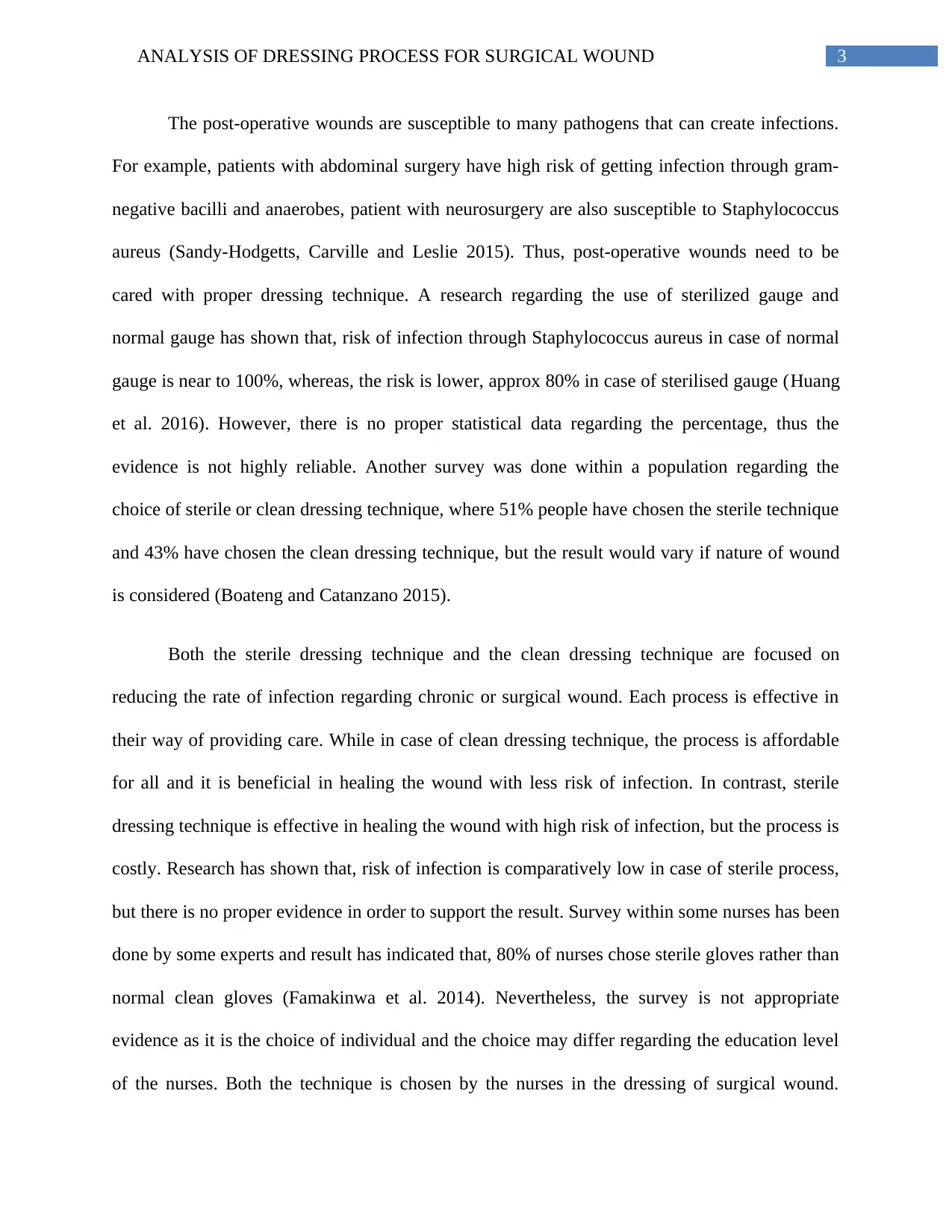
3ANALYSIS OF DRESSING PROCESS FOR SURGICAL WOUND
The post-operative wounds are susceptible to many pathogens that can create infections.
For example, patients with abdominal surgery have high risk of getting infection through gram-
negative bacilli and anaerobes, patient with neurosurgery are also susceptible to Staphylococcus
aureus (Sandy‐Hodgetts, Carville and Leslie 2015). Thus, post-operative wounds need to be
cared with proper dressing technique. A research regarding the use of sterilized gauge and
normal gauge has shown that, risk of infection through Staphylococcus aureus in case of normal
gauge is near to 100%, whereas, the risk is lower, approx 80% in case of sterilised gauge (Huang
et al. 2016). However, there is no proper statistical data regarding the percentage, thus the
evidence is not highly reliable. Another survey was done within a population regarding the
choice of sterile or clean dressing technique, where 51% people have chosen the sterile technique
and 43% have chosen the clean dressing technique, but the result would vary if nature of wound
is considered (Boateng and Catanzano 2015).
Both the sterile dressing technique and the clean dressing technique are focused on
reducing the rate of infection regarding chronic or surgical wound. Each process is effective in
their way of providing care. While in case of clean dressing technique, the process is affordable
for all and it is beneficial in healing the wound with less risk of infection. In contrast, sterile
dressing technique is effective in healing the wound with high risk of infection, but the process is
costly. Research has shown that, risk of infection is comparatively low in case of sterile process,
but there is no proper evidence in order to support the result. Survey within some nurses has been
done by some experts and result has indicated that, 80% of nurses chose sterile gloves rather than
normal clean gloves (Famakinwa et al. 2014). Nevertheless, the survey is not appropriate
evidence as it is the choice of individual and the choice may differ regarding the education level
of the nurses. Both the technique is chosen by the nurses in the dressing of surgical wound.
The post-operative wounds are susceptible to many pathogens that can create infections.
For example, patients with abdominal surgery have high risk of getting infection through gram-
negative bacilli and anaerobes, patient with neurosurgery are also susceptible to Staphylococcus
aureus (Sandy‐Hodgetts, Carville and Leslie 2015). Thus, post-operative wounds need to be
cared with proper dressing technique. A research regarding the use of sterilized gauge and
normal gauge has shown that, risk of infection through Staphylococcus aureus in case of normal
gauge is near to 100%, whereas, the risk is lower, approx 80% in case of sterilised gauge (Huang
et al. 2016). However, there is no proper statistical data regarding the percentage, thus the
evidence is not highly reliable. Another survey was done within a population regarding the
choice of sterile or clean dressing technique, where 51% people have chosen the sterile technique
and 43% have chosen the clean dressing technique, but the result would vary if nature of wound
is considered (Boateng and Catanzano 2015).
Both the sterile dressing technique and the clean dressing technique are focused on
reducing the rate of infection regarding chronic or surgical wound. Each process is effective in
their way of providing care. While in case of clean dressing technique, the process is affordable
for all and it is beneficial in healing the wound with less risk of infection. In contrast, sterile
dressing technique is effective in healing the wound with high risk of infection, but the process is
costly. Research has shown that, risk of infection is comparatively low in case of sterile process,
but there is no proper evidence in order to support the result. Survey within some nurses has been
done by some experts and result has indicated that, 80% of nurses chose sterile gloves rather than
normal clean gloves (Famakinwa et al. 2014). Nevertheless, the survey is not appropriate
evidence as it is the choice of individual and the choice may differ regarding the education level
of the nurses. Both the technique is chosen by the nurses in the dressing of surgical wound.
Paraphrase This Document
Need a fresh take? Get an instant paraphrase of this document with our AI Paraphraser
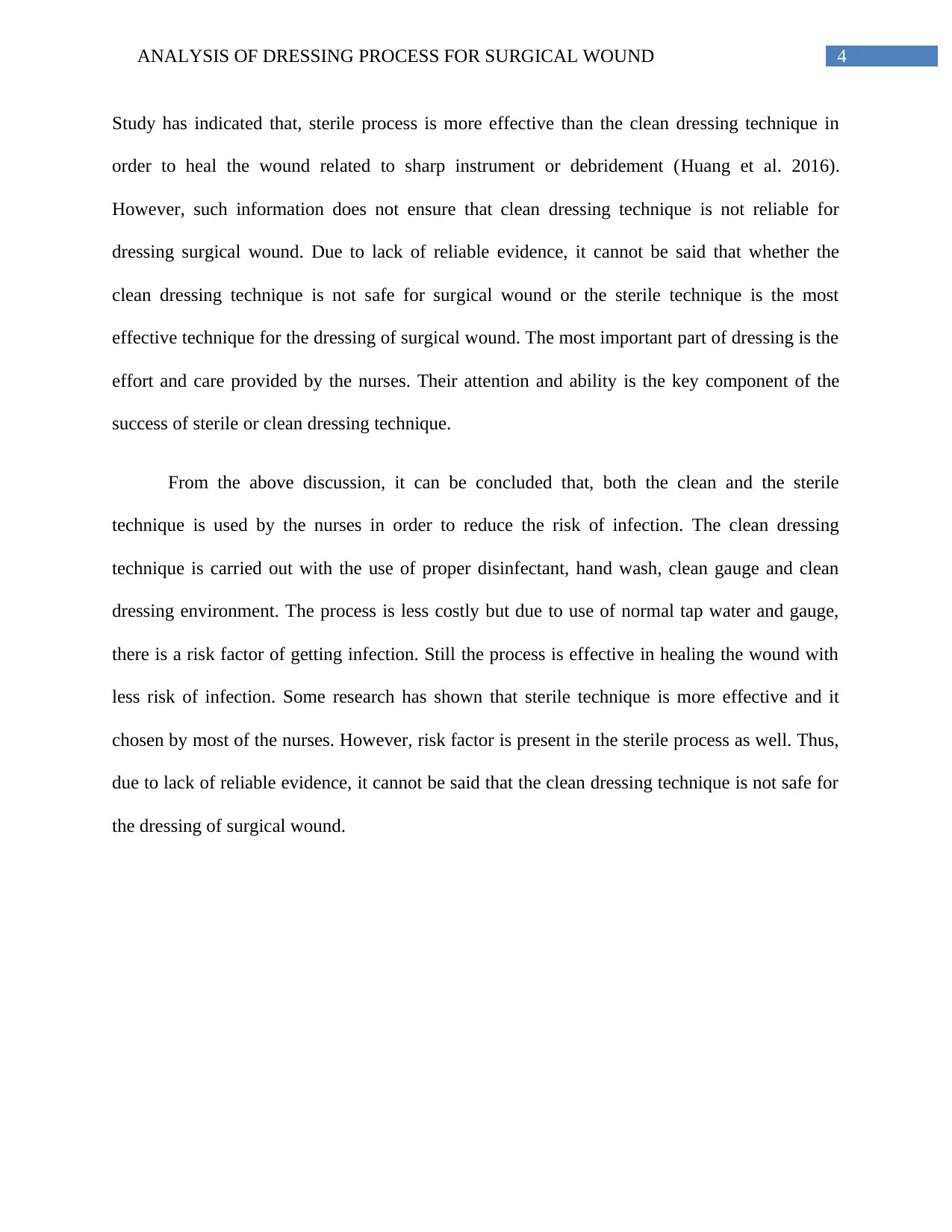
4ANALYSIS OF DRESSING PROCESS FOR SURGICAL WOUND
Study has indicated that, sterile process is more effective than the clean dressing technique in
order to heal the wound related to sharp instrument or debridement (Huang et al. 2016).
However, such information does not ensure that clean dressing technique is not reliable for
dressing surgical wound. Due to lack of reliable evidence, it cannot be said that whether the
clean dressing technique is not safe for surgical wound or the sterile technique is the most
effective technique for the dressing of surgical wound. The most important part of dressing is the
effort and care provided by the nurses. Their attention and ability is the key component of the
success of sterile or clean dressing technique.
From the above discussion, it can be concluded that, both the clean and the sterile
technique is used by the nurses in order to reduce the risk of infection. The clean dressing
technique is carried out with the use of proper disinfectant, hand wash, clean gauge and clean
dressing environment. The process is less costly but due to use of normal tap water and gauge,
there is a risk factor of getting infection. Still the process is effective in healing the wound with
less risk of infection. Some research has shown that sterile technique is more effective and it
chosen by most of the nurses. However, risk factor is present in the sterile process as well. Thus,
due to lack of reliable evidence, it cannot be said that the clean dressing technique is not safe for
the dressing of surgical wound.
Study has indicated that, sterile process is more effective than the clean dressing technique in
order to heal the wound related to sharp instrument or debridement (Huang et al. 2016).
However, such information does not ensure that clean dressing technique is not reliable for
dressing surgical wound. Due to lack of reliable evidence, it cannot be said that whether the
clean dressing technique is not safe for surgical wound or the sterile technique is the most
effective technique for the dressing of surgical wound. The most important part of dressing is the
effort and care provided by the nurses. Their attention and ability is the key component of the
success of sterile or clean dressing technique.
From the above discussion, it can be concluded that, both the clean and the sterile
technique is used by the nurses in order to reduce the risk of infection. The clean dressing
technique is carried out with the use of proper disinfectant, hand wash, clean gauge and clean
dressing environment. The process is less costly but due to use of normal tap water and gauge,
there is a risk factor of getting infection. Still the process is effective in healing the wound with
less risk of infection. Some research has shown that sterile technique is more effective and it
chosen by most of the nurses. However, risk factor is present in the sterile process as well. Thus,
due to lack of reliable evidence, it cannot be said that the clean dressing technique is not safe for
the dressing of surgical wound.
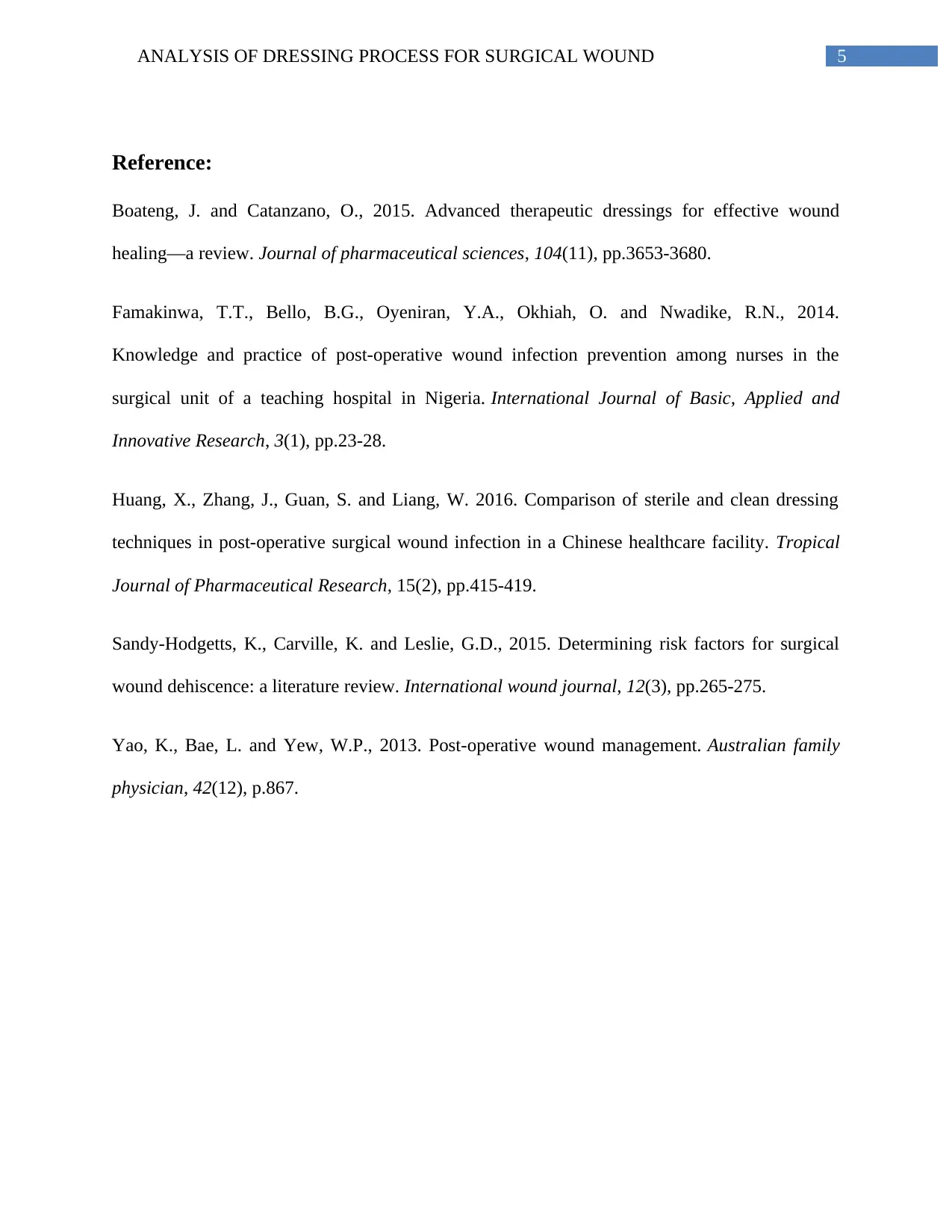
5ANALYSIS OF DRESSING PROCESS FOR SURGICAL WOUND
Reference:
Boateng, J. and Catanzano, O., 2015. Advanced therapeutic dressings for effective wound
healing—a review. Journal of pharmaceutical sciences, 104(11), pp.3653-3680.
Famakinwa, T.T., Bello, B.G., Oyeniran, Y.A., Okhiah, O. and Nwadike, R.N., 2014.
Knowledge and practice of post-operative wound infection prevention among nurses in the
surgical unit of a teaching hospital in Nigeria. International Journal of Basic, Applied and
Innovative Research, 3(1), pp.23-28.
Huang, X., Zhang, J., Guan, S. and Liang, W. 2016. Comparison of sterile and clean dressing
techniques in post-operative surgical wound infection in a Chinese healthcare facility. Tropical
Journal of Pharmaceutical Research, 15(2), pp.415-419.
Sandy‐Hodgetts, K., Carville, K. and Leslie, G.D., 2015. Determining risk factors for surgical
wound dehiscence: a literature review. International wound journal, 12(3), pp.265-275.
Yao, K., Bae, L. and Yew, W.P., 2013. Post-operative wound management. Australian family
physician, 42(12), p.867.
Reference:
Boateng, J. and Catanzano, O., 2015. Advanced therapeutic dressings for effective wound
healing—a review. Journal of pharmaceutical sciences, 104(11), pp.3653-3680.
Famakinwa, T.T., Bello, B.G., Oyeniran, Y.A., Okhiah, O. and Nwadike, R.N., 2014.
Knowledge and practice of post-operative wound infection prevention among nurses in the
surgical unit of a teaching hospital in Nigeria. International Journal of Basic, Applied and
Innovative Research, 3(1), pp.23-28.
Huang, X., Zhang, J., Guan, S. and Liang, W. 2016. Comparison of sterile and clean dressing
techniques in post-operative surgical wound infection in a Chinese healthcare facility. Tropical
Journal of Pharmaceutical Research, 15(2), pp.415-419.
Sandy‐Hodgetts, K., Carville, K. and Leslie, G.D., 2015. Determining risk factors for surgical
wound dehiscence: a literature review. International wound journal, 12(3), pp.265-275.
Yao, K., Bae, L. and Yew, W.P., 2013. Post-operative wound management. Australian family
physician, 42(12), p.867.
⊘ This is a preview!⊘
Do you want full access?
Subscribe today to unlock all pages.

Trusted by 1+ million students worldwide
1 out of 6
Related Documents
Your All-in-One AI-Powered Toolkit for Academic Success.
+13062052269
info@desklib.com
Available 24*7 on WhatsApp / Email
![[object Object]](/_next/static/media/star-bottom.7253800d.svg)
Unlock your academic potential
Copyright © 2020–2025 A2Z Services. All Rights Reserved. Developed and managed by ZUCOL.





